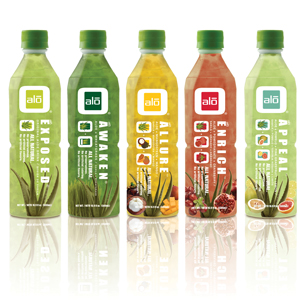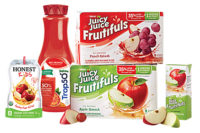
|
Long known as a skin soother, aloe has a reputation in the United States for its inherent external benefits. Riding the health and wellness trend, aloe suppliers and beverage-makers are working to expand consumers’ knowledge about the benefits of consuming aloe.
“Aloe is one ingredient that does not require brand building,” says Patrick Anderson, western regional sales manager for Terry Labs, Melbourne, Fla. “Most consumers recognize it for [the plant’s] internal wonders. These consumers are more likely to try a drink with aloe because it is recognized as a benefit to the body.”
When aloe is consumed as a beverage, it functions as a digestive aid by correcting ailments within the digestive system, an aid to bladder issues, and a carrier to get vitamins into the bloodstream faster and keep them there longer, Anderson says.
Studies also have shown that aloe-based supplements can enhance the bioavailability of vitamins C, E and B12, explains Jeff Barrie, eastern regional sales manager for Aloecorp, Keene, N.J. Human clinical studies also have shown that aloe supplements can be beneficial for immune health, oxidative stress, interior beauty and skin health, Barrie says.
In addition, a study conducted at the University of California-Davis found that a supplement of aloe was effective in lowering LDL cholesterol, fasting blood glucose and fructosamine in individuals who had impaired fasting glucose and impaired glucose tolerance, both of which are linked to metabolic syndrome, which is regarded as a precursor to diabetes.
SPI West Port Inc., South San Francisco, Calif., first launched its Alō Drink line of aloe vera-based beverages nearly three years ago. The company has seen the product expand from the natural foods channel into mainstream grocery outlets as well as drug stores, says Henry Chen, president of SPI West Port.
“We’re fortunate that everybody kind of knows aloe vera,” Chen says. “It has always had some kind of mystical sort of quality to it; people put it on their skin for burns and so forth. It’s not one of those ingredients where you really have to convince the consumer that it’s good. What we have to convince them is that you can actually ingest it, you can actually eat it.”
Adding aloe
Although many consumers likely think of aloe as the bright green gel sold to soothe skin irritations and sunburns, the plant also is available in several consumable formats.
Terry Labs offers various forms of aloe, such as freeze-dried and spray-dried powders as well as both inner filet and whole leaf liquids. Freeze-dried powders tend to be a favorite of beverage-makers, Anderson says, because of their ability to dissolve into solutions faster than spray-dried powder.
The company’s inner filet and whole leaf liquids are suited for drinks because they do not require additional water with the formula and can be added directly as the base for a formula or enhancement, Anderson says.
In addition to formulating a beverage with aloe vera, the addition of natural flavoring, such as berry, citrus and mango, helps to mask the taste of aloe and make drinks more flavorful, Anderson says.
“Rather than being incorporated in beverages, aloe should be used as the base or primary ingredient, and flavors or additives can be used to satisfy local markets and preferences,” Anderson explains.
Terry Labs also offers a powder made from nopal, which is made from the pad segments of prickly pear plants. Nopal powder has similar properties as aloe and performs exceptionally well for people who have type 2 diabetes, Anderson says. The powder has been used for many years in Mexico and slowly is catching on in the United States, he says.
Aloecorp offers aloe vera juice, aloe vera 10X concentrate and aloe vera 200X powder. Barrie says the company recommends its ActivAloe aloe vera gel 200X, which has generally recognized as safe status. Aloecorp’s ActivAloe gel ingredient can be used in juice, milk, yogurt, fruit smoothies and additional beverage applications, he says.
“For those of us who have spent many years in the aloe business, this is a very exciting time,” Barrie says. “For many years people have associated aloe vera with skincare products, but for many years many people have enjoyed the benefits of drinking aloe. It’s exciting and encouraging to see the interest in aloe vera for beverages and to see new aloe drinks hitting store shelves.”
SPI West Port and its Alō Drink line is among the leaders in aloe vera-based beverages. Both Alō Drink and the company’s latest release Coco Exposed are made using aloe pulp and juice that is extracted from the aloe vera plant, not reconstituted from powder, Chen says. The company uses a hand-fileting method to extract only the water-saturated aloe vera pulp from the leaf, he says.
The Alō Drink line is available in seven varieties that each contains 25 percent aloe vera juice and pulp. The line includes Alō Exposed that is made with aloe vera and honey; Alō Elated featuring aloe vera and olive leaf tea; Alō Enrich with aloe vera, pomegranate and cranberry; and Alō Enliven that combines aloe vera with 12 fruits and vegetables.
“We find that the majority of people aren’t going to our drinks for their functionality, they’re going because they tried it, they tasted it and they like the refreshing taste,” he says. “They also like the texture of the aloe pulp; it’s not something that has really been prevalent in most mainstream beverages.”
Based on the brand’s success in Hawaii, SPI West Port is developing an Alō Drink flavor that would be well-suited to the tastes of the island region, Chen says.
Earlier this year, SPI West Port expanded its aloe vera-based beverage line with the addition of Coco Exposed. The line combines aloe vera juice and pulp with coconut water in five varieties: Wheatgrass; Passion Fruit and Pineapple; Peach and Kiwi; Mangosteen and Mango; and Goji Berry and Lychee. Coco Exposed was developed in part due to consumer requests, Chen says.
“Some of our fans were asking for beverages that had even less sugar than we have in our Alō Drink line,” he says. “We thought that [aloe vera and coconut water] would be a good combination because in our Coco Exposed line we don’t have any added sugar; the sugars are coming from the fruits and the natural sugars.”
The company began with distribution in natural food retailers, such as Whole Foods Market, Sprouts and Cost Plus World Market, and recently Alō Drinks have started to go more mainstream with placement in Safeway, Hy-Vee and Treasure Island stores, Chen says. In addition, Alō Drinks have found success in certain Costco, Walgreens and CVS locations and are available in Vitamin Shoppe stores nationally, he says.
“Our core demographic originally was those who care about what they put in their body, enjoy healthy living and are trend leaders, but who won’t compromise on taste,” Chen says. “More and more, however, our fan base is expanding to consumers who come back to our drinks because of the great taste and are happy to find a better, healthier alternative to sugary drinks.” BI



